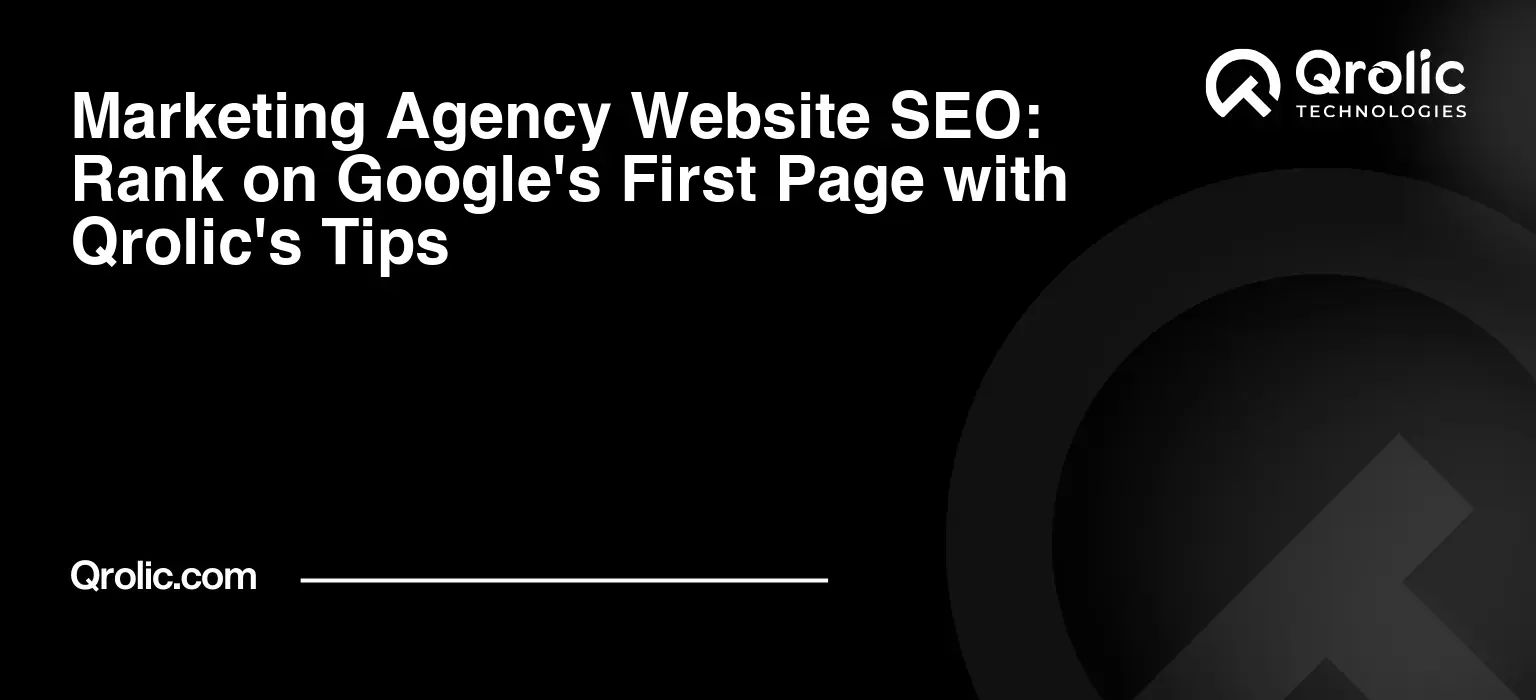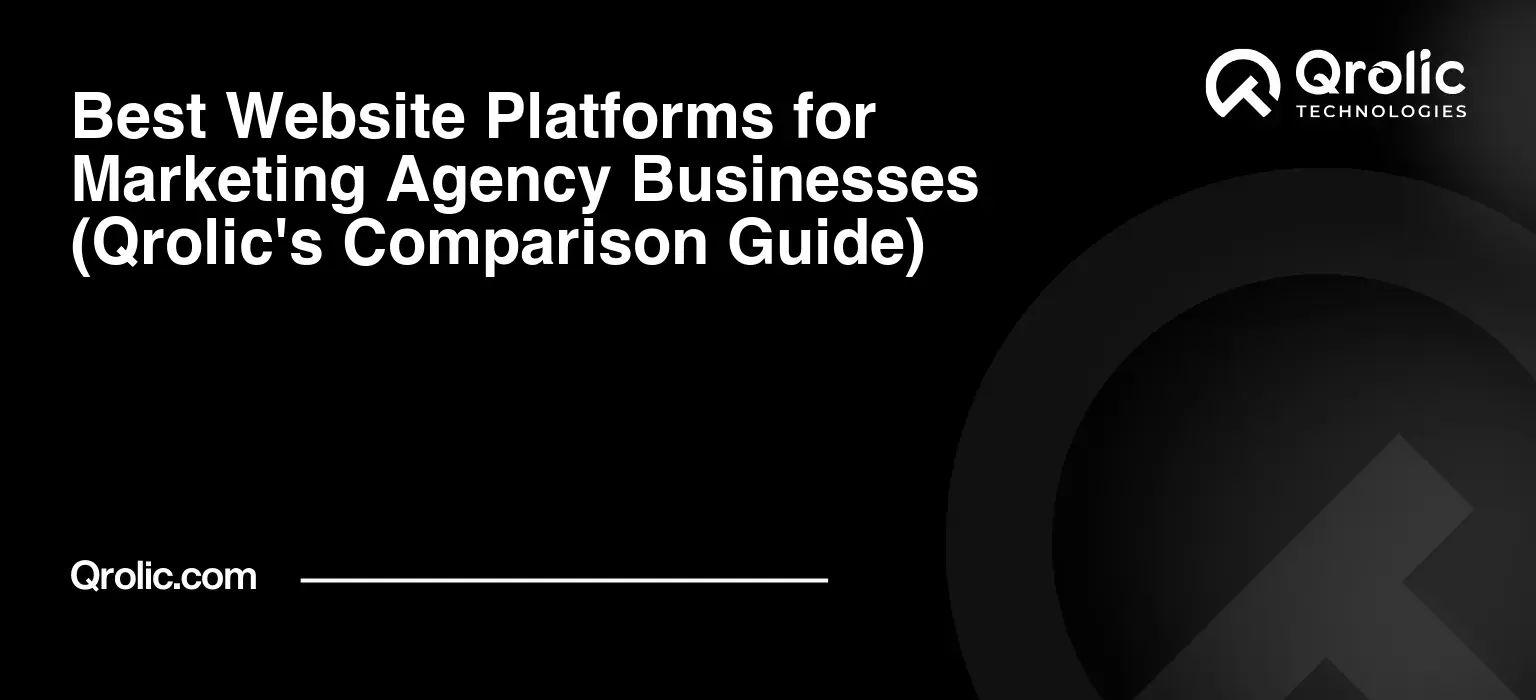Quick Summary:
- Plan your niche, goals, and keywords first.
- Design for users with consistent branding.
- Create compelling content, case studies, and testimonials.
- Optimize for speed, mobile, and ongoing SEO.
Table of Contents
- I. Laying the Foundation: Planning and Strategy
- A. Defining Your Niche and Target Audience: Who Are You Talking To?
- B. Defining Your Website’s Purpose and Goals: What Do You Want to Achieve?
- C. Keyword Research: Speaking Your Audience’s Language
- D. Sitemap and Information Architecture: Mapping the User Journey
- II. Crafting the Visual Experience: Design and Branding
- A. Branding Consistency: Extending Your Agency’s Identity Online
- B. Website Design Principles: User-Centric Design
- C. Choosing the Right Visuals: Imagery and Video
- D. Color Psychology: Evoking the Right Emotions
- III. Content is King: Crafting Compelling Messaging
- A. Writing Compelling Copy: Engaging Your Audience
- B. Showcasing Your Expertise: Case Studies and Portfolio
- C. Building Trust with Testimonials: Social Proof
- D. Blogging for SEO and Thought Leadership: Content Marketing
- IV. Technical SEO and Performance: Ensuring a Smooth Ride
- A. Website Speed Optimization: Performance Matters
- B. Mobile-Friendliness: Adapting to the Mobile World
- C. Schema Markup: Helping Search Engines Understand Your Content
- D. Website Security: Protecting Your Data and Visitors
- V. Setting Up Your Agency Website: Platform & Hosting
- A. Choosing a CMS: WordPress and Beyond
- B. Selecting a Web Hosting Provider: Reliability and Performance
- C. Setting Up Your Domain: Brand Visibility
- VI. Promotion and Optimization: Launching and Growing
- A. SEO Best Practices: Ranking Higher
- B. Social Media Integration: Amplifying Your Reach
- C. Email Marketing: Nurturing Leads
- D. Analytics and Tracking: Measuring Success
- VII. Qrolic Technologies: Your Partner in Digital Web Design
- VIII. Conclusion: Building a Digital Asset
I. Laying the Foundation: Planning and Strategy
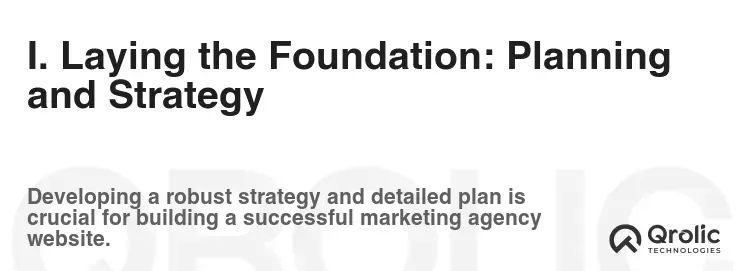
A. Defining Your Niche and Target Audience: Who Are You Talking To?
Before a single line of code is written or a pixel is painted, you need absolute clarity on your marketing agency’s niche and who your ideal client is. This isn’t just about slapping a label on yourself; it’s about deeply understanding the pain points, aspirations, and communication styles of the people you want to serve.
-
Why is this crucial? A focused niche allows you to tailor your website’s messaging, design, and content to resonate powerfully with a specific audience. Imagine trying to sell bespoke suits to teenagers – it wouldn’t work. Similarly, a generic marketing agency website that tries to appeal to everyone will likely appeal to no one.
How to define your niche:
- Identify your expertise: What are you really good at? What services do you enjoy providing? This could be anything from SEO for e-commerce businesses to social media marketing for restaurants.
- Analyze your competition: Who else is operating in the same space? What are they doing well? Where are the gaps you can fill?
- Research market demand: Is there a genuine need for your specialized services? Use tools like Google Keyword Planner or SEMrush to gauge search volume and competition for relevant keywords (e.g., “SEO for startups,” “social media for dentists”).
- Consider profitability: Can you charge enough for your services to make your niche worthwhile?
-
Creating Ideal Client Personas: Once you have a niche, develop detailed profiles of your ideal clients. Go beyond basic demographics like age and location. Consider their:
- Industry: What industry do they operate in?
- Company Size: Are they a small business, a mid-sized company, or a large enterprise?
- Revenue: What is their annual revenue? This helps you understand their budget for marketing.
- Pain Points: What marketing challenges are they facing? What keeps them up at night?
- Goals: What are they trying to achieve with their marketing efforts?
- Values: What do they care about? What are their ethical considerations?
- Preferred Communication Style: How do they prefer to be contacted? What kind of language do they use?
For example, your ideal client persona might be “Sarah, the owner of a growing e-commerce business selling handmade jewelry. She’s struggling to get her products seen online and feels overwhelmed by the complexities of SEO and paid advertising. She wants to increase her website traffic, boost sales, and build a loyal customer base. She’s looking for a marketing agency that is transparent, data-driven, and genuinely cares about her business.”
B. Defining Your Website’s Purpose and Goals: What Do You Want to Achieve?
Your marketing agency website shouldn’t just be a digital brochure; it should be a strategic tool that helps you achieve specific business objectives.
-
Why is this crucial? Clearly defined goals will guide your website’s design, content, and functionality. Without them, you’ll end up with a website that looks pretty but doesn’t deliver results.
Common website goals for marketing agencies:
- Generate leads: Capture contact information from potential clients.
- Build brand awareness: Establish your agency as a thought leader in your niche.
- Showcase your expertise: Demonstrate your skills and experience through case studies, testimonials, and blog posts.
- Attract top talent: Recruit talented marketing professionals to join your team.
- Sell services directly: Offer packaged services or consultations through your website.
- Reduce client onboarding time: Provide resources and information to streamline the onboarding process.
Setting SMART Goals: Ensure your goals are Specific, Measurable, Achievable, Relevant, and Time-bound. For example:
- Instead of: “Generate more leads.”
- Try: “Increase qualified leads generated through the website by 20% in the next quarter.”
C. Keyword Research: Speaking Your Audience’s Language
Keyword research is the cornerstone of SEO and will inform your website’s content strategy. It’s about understanding the words and phrases your target audience uses when searching for marketing services online.
-
Why is this crucial? Using the right keywords in your website’s content will help you rank higher in search engine results, making it easier for potential clients to find you.
How to conduct keyword research:
-
Brainstorm: Start by listing the keywords and phrases that you think potential clients might use to find your services (e.g., “social media marketing agency,” “SEO services for small business,” “content marketing strategy”).
-
Use keyword research tools: Tools like Google Keyword Planner, SEMrush, Ahrefs, and Moz Keyword Explorer can help you discover related keywords, analyze search volume, and assess competition.
-
Analyze your competitors: See what keywords your competitors are ranking for. This can give you valuable insights into potential opportunities.
-
Focus on long-tail keywords: These are longer, more specific phrases (e.g., “best SEO company for e-commerce in Los Angeles”). They tend to have lower search volume but also lower competition, making them easier to rank for.
-
Consider user intent: What are people really looking for when they search for a particular keyword? Are they looking for information, a product, or a service? Tailor your content to match their intent.
Example Keywords:
- Primary: marketing agency creation, digital web design,
- Secondary: marketing agency website, create agency website, agency website design, web design for marketing agency, marketing agency website builder, affordable web design agency, digital marketing agency website design, best marketing agency website, marketing website design, marketing agency site.
-
D. Sitemap and Information Architecture: Mapping the User Journey
A well-structured sitemap is essential for both user experience (UX) and SEO. It helps visitors easily navigate your website and allows search engines to crawl and index your content efficiently.
-
Why is this crucial? A confusing or poorly organized website will frustrate visitors and make it difficult for them to find the information they need. This will lead to high bounce rates and low conversion rates.
Key pages to include in your sitemap:
- Homepage: Your website’s front door, designed to grab attention and guide visitors further.
- About Us: Tell your story, showcase your team, and highlight your values.
- Services: Clearly describe the services you offer and the benefits they provide.
- Case Studies: Demonstrate your expertise with real-world examples of your work.
- Blog: Share valuable insights, industry news, and thought leadership content.
- Contact Us: Make it easy for potential clients to get in touch with you.
- Portfolio: Showcase your best work and demonstrate your design capabilities.
- Testimonials: Social proof from happy clients adds credibility.
- Pricing (Optional): If you offer packaged services, consider displaying your pricing.
Creating a logical and intuitive structure:
- Keep it simple: Avoid too many levels of navigation.
- Use clear and concise labels: Make sure your navigation labels are easy to understand.
- Prioritize important pages: Place your most important pages in prominent locations.
- Use a hierarchical structure: Organize your content into logical categories and subcategories.
- Include a search bar: Allow visitors to quickly find specific information.
II. Crafting the Visual Experience: Design and Branding
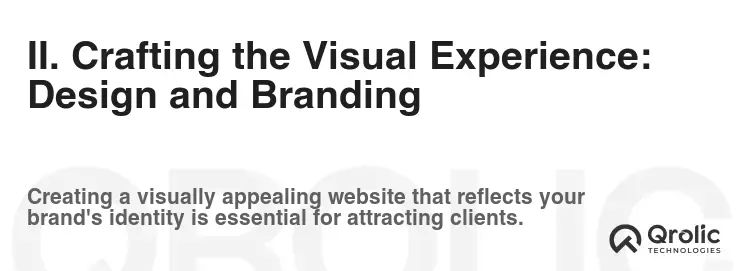
A. Branding Consistency: Extending Your Agency’s Identity Online
Your website is an extension of your brand. It should reflect your agency’s personality, values, and visual identity.
-
Why is this crucial? Consistent branding builds trust, strengthens recognition, and helps you stand out from the competition.
Key elements of branding consistency:
- Logo: Use your logo consistently across your website and other marketing materials.
- Color Palette: Choose a color palette that reflects your brand’s personality and use it consistently throughout your website.
- Typography: Select fonts that are easy to read and consistent with your brand’s style.
- Imagery: Use high-quality images and videos that are relevant to your brand and target audience.
- Tone of Voice: Maintain a consistent tone of voice in your website copy and other content.
B. Website Design Principles: User-Centric Design
Your website’s design should be focused on creating a positive user experience.
-
Why is this crucial? A user-friendly website will encourage visitors to stay longer, explore your content, and ultimately convert into leads or clients.
Key design principles:
- Simplicity: Keep the design clean and uncluttered. Avoid unnecessary elements that can distract visitors.
- Visual Hierarchy: Guide the user’s eye to the most important elements on the page. Use size, color, and placement to create a clear visual hierarchy.
- Whitespace: Use whitespace effectively to create breathing room and improve readability.
- Mobile-First Design: Ensure your website is fully responsive and looks great on all devices, especially mobile.
- Accessibility: Design your website to be accessible to people with disabilities. Follow WCAG guidelines.
- Fast Loading Speed: Optimize your website for speed. slow loading times can frustrate visitors and negatively impact your SEO.
- Intuitive Navigation: Make it easy for visitors to find the information they need.
C. Choosing the Right Visuals: Imagery and Video
High-quality visuals can significantly enhance your website’s appeal and effectiveness.
-
Why is this crucial? Visuals can capture attention, convey complex information, and evoke emotions.
Types of visuals to use:
- Professional Photography: Use professional photos of your team, office, and work.
- Stock Photos: Choose stock photos carefully to ensure they are relevant and high-quality. Avoid generic or cheesy stock photos.
- Illustrations: Use custom illustrations to add a unique touch to your website.
- Videos: Create videos to showcase your services, team culture, and client testimonials.
- Infographics: Use infographics to present data and information in a visually appealing way.
optimizing visuals for the web:
- Compress images: Reduce file sizes without sacrificing quality to improve loading speed.
- Use appropriate file formats: Use JPEG for photos and PNG for graphics with transparency.
- Add alt text: Provide descriptive alt text for all images to improve accessibility and SEO.
D. Color Psychology: Evoking the Right Emotions
Colors can have a powerful impact on people’s emotions and perceptions.
-
Why is this crucial? Choosing the right colors for your website can help you create a specific mood and communicate your brand’s personality.
Common color associations:
- Blue: Trust, reliability, stability
- Green: Growth, nature, health
- Red: Energy, excitement, passion
- Yellow: Optimism, happiness, creativity
- Purple: Luxury, sophistication, wisdom
- Orange: Enthusiasm, friendliness, innovation
Choosing a color palette:
- Consider your brand’s personality: What emotions do you want to evoke?
- Research your target audience: What colors resonate with them?
- Use a color wheel: Experiment with different color combinations to find a palette that works well together.
- Test your color palette: Get feedback from others to see how they perceive your colors.
III. Content is King: Crafting Compelling Messaging
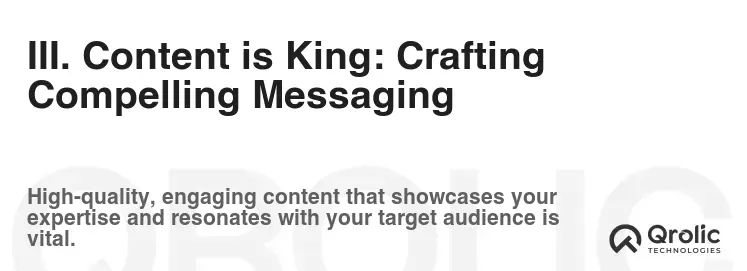
A. Writing Compelling Copy: Engaging Your Audience
Your website’s copy should be clear, concise, and engaging. It should tell your story, highlight your expertise, and persuade visitors to take action.
-
Why is this crucial? Well-written copy can capture attention, build trust, and drive conversions.
Key principles of effective copywriting:
- Know your audience: Write for your ideal client persona. Use their language and address their pain points.
- Focus on benefits, not features: Explain how your services will benefit your clients. What problems will you solve? What results will you deliver?
- Use strong headlines: Your headlines should grab attention and entice visitors to read further.
- Keep it simple: Use clear and concise language. Avoid jargon and technical terms.
- Use a conversational tone: Write as if you’re speaking directly to your audience.
- Use visuals to break up text: Use images, videos, and infographics to make your content more engaging.
- Include a call to action: Tell visitors what you want them to do. Use strong action verbs like “Get a Free Quote,” “Contact Us,” or “Download Now.”
B. Showcasing Your Expertise: Case Studies and Portfolio
Case studies and portfolio pieces are powerful ways to demonstrate your expertise and build credibility.
-
Why is this crucial? They provide real-world examples of your work and show potential clients what you’re capable of.
Creating effective case studies:
- Choose compelling projects: Select projects that showcase your best work and deliver impressive results.
- Tell a story: Explain the challenges the client faced, the solutions you provided, and the results you achieved.
- Use data and metrics: Quantify your results with data and metrics to demonstrate the impact of your work.
- Include client testimonials: Add quotes from satisfied clients to add credibility.
- Use visuals: Include images, videos, and screenshots to illustrate your work.
Building a compelling portfolio:
- Showcase your best work: Only include your strongest and most relevant projects.
- Categorize your work: Organize your portfolio by service type or industry to make it easier for visitors to find what they’re looking for.
- Provide detailed descriptions: Explain the project goals, your role, and the results you achieved.
- Use high-quality images and videos: Present your work in the best possible light.
C. Building Trust with Testimonials: Social Proof
Testimonials are a powerful form of social proof that can significantly increase your website’s credibility.
-
Why is this crucial? Potential clients are more likely to trust recommendations from other satisfied customers than claims made by your agency.
Gathering testimonials:
- Ask for them: Don’t be afraid to ask your satisfied clients for testimonials.
- Make it easy: Provide clients with a template or questionnaire to guide them.
- Record video testimonials: Video testimonials are even more powerful than written ones.
- Use platforms like LinkedIn: Look for recommendations on LinkedIn.
Displaying testimonials effectively:
- Feature real people: Include photos and names of the people providing the testimonials.
- Highlight key benefits: Choose testimonials that highlight the specific benefits of your services.
- Place testimonials strategically: Display testimonials on your homepage, services pages, and case studies.
D. Blogging for SEO and Thought Leadership: Content Marketing
A blog is an essential tool for driving traffic to your website, building brand awareness, and establishing yourself as a thought leader in your niche.
-
Why is this crucial? Regular blog posts provide fresh content for search engines to index, attract new visitors, and nurture leads.
Creating a successful blog:
- Choose relevant topics: Write about topics that are of interest to your target audience and related to your services.
- Conduct keyword research: Use keywords to optimize your blog posts for search engines.
- Write high-quality content: Provide valuable information, insights, and advice.
- Promote your blog posts: Share your blog posts on social media, email, and other channels.
- Be consistent: Publish new blog posts regularly to keep your audience engaged.
IV. Technical SEO and Performance: Ensuring a Smooth Ride
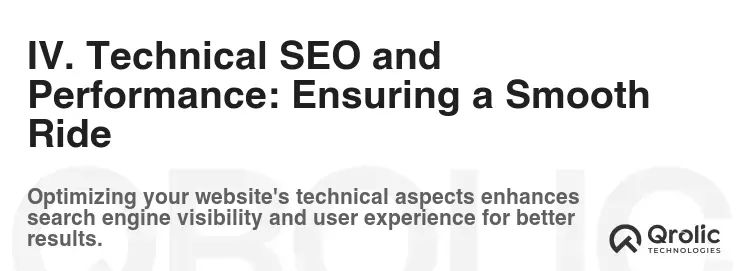
A. Website Speed Optimization: Performance Matters
Website speed is a critical factor for both user experience and SEO.
-
Why is this crucial? slow loading times can frustrate visitors, increase bounce rates, and negatively impact your search engine rankings.
Strategies for optimizing website speed:
- Optimize images: Compress images and use appropriate file formats.
- Enable browser caching: Allow browsers to cache static resources.
- Minify CSS and JavaScript: Reduce the size of your CSS and JavaScript files.
- Use a content delivery network (CDN): Distribute your website’s content across multiple servers to improve loading speed for users around the world.
- Choose a fast web hosting provider: Select a web hosting provider that offers fast servers and reliable performance.
- Optimize your database: Optimize your database queries to improve performance.
Tools for measuring website speed:
- Google PageSpeed Insights: Provides detailed recommendations for improving website speed.
- GTmetrix: Offers comprehensive performance analysis and insights.
- WebPageTest: Allows you to test your website’s speed from different locations.
B. Mobile-Friendliness: Adapting to the Mobile World
With the majority of internet users accessing websites on mobile devices, it’s essential to ensure your website is fully responsive and mobile-friendly.
-
Why is this crucial? Google uses mobile-first indexing, meaning it primarily crawls and indexes the mobile version of your website.
Key principles of mobile-friendly design:
- Responsive design: Use a responsive design framework to ensure your website adapts to different screen sizes.
- Touch-friendly navigation: Make sure your navigation is easy to use on touchscreens.
- Large fonts: Use large enough fonts to be easily readable on mobile devices.
- Avoid Flash: Flash is not supported on most mobile devices.
- Test your website on different devices: Test your website on a variety of mobile devices to ensure it looks and functions properly.
Tools for testing mobile-friendliness:
- Google Mobile-Friendly Test: Checks if your website is mobile-friendly.
C. Schema Markup: Helping Search Engines Understand Your Content
Schema markup is structured data that you can add to your website’s HTML to help search engines understand the content on your pages.
-
Why is this crucial? Schema markup can improve your website’s visibility in search engine results and make it more likely that users will click on your listing.
Types of schema markup:
- Organization: Provides information about your agency, such as your name, address, and phone number.
- Service: Describes the services you offer.
- Article: Identifies your blog posts as articles.
- Review: Displays reviews and ratings from your clients.
- LocalBusiness: Provides information about your agency if you have a physical location.
Tools for generating schema markup:
- Google Structured Data Markup Helper: Helps you generate schema markup code.
D. Website Security: Protecting Your Data and Visitors
Website security is paramount.
-
Why is this crucial? A security breach can damage your reputation, expose sensitive data, and negatively impact your SEO.
Key security measures:
- Use HTTPS: Encrypt your website’s traffic with HTTPS.
- Use strong passwords: Use strong and unique passwords for all your accounts.
- Keep your software up to date: Regularly update your website’s CMS, plugins, and themes.
- Use a web application firewall (WAF): Protect your website from common attacks.
- Back up your website regularly: Back up your website’s files and database regularly.
V. Setting Up Your Agency Website: Platform & Hosting
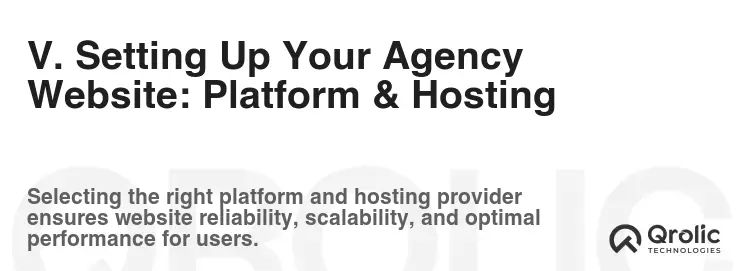
A. Choosing a CMS: WordPress and Beyond
Selecting the right Content Management System (CMS) is a crucial decision.
-
Why is this crucial? The CMS will dictate the ease of website management, flexibility in design, and overall scalability.
Popular CMS Options:
- WordPress: The most popular CMS, offering vast plugin and theme options. Ideal for content-focused websites.
- Webflow: A powerful visual development platform suited for designers who prefer a no-code approach. It offers more design freedom than WordPress.
- Squarespace: An easy-to-use platform, ideal for simple websites. It’s less flexible than WordPress or Webflow but requires less technical expertise.
- Joomla: A flexible CMS that is more complex than WordPress, best for users with development experience.
- Drupal: A highly customizable CMS, ideal for complex and large-scale websites. Requires significant technical expertise.
Considerations when choosing a CMS:
- Ease of use: How easy is the CMS to learn and use?
- Flexibility: How much control do you have over the design and functionality of your website?
- Scalability: Can the CMS handle your website’s growing traffic and content?
- SEO-friendliness: Is the CMS optimized for search engines?
- Security: How secure is the CMS?
- Cost: How much does the CMS cost, including themes, plugins, and hosting?
B. Selecting a Web Hosting Provider: Reliability and Performance
Your web hosting provider plays a crucial role in your website’s performance, security, and reliability.
-
Why is this crucial? A reliable hosting provider will ensure your website is always online and loads quickly.
Types of web hosting:
- Shared Hosting: The most affordable option, but performance can be affected by other websites on the same server.
- VPS Hosting: Offers more resources and control than shared hosting.
- Dedicated Hosting: Provides a dedicated server for your website. The most expensive option, but offers the best performance and control.
- Cloud Hosting: Uses a network of servers to host your website, offering scalability and reliability.
- Managed WordPress Hosting: Optimized for WordPress websites, offering features like automatic updates and security scans.
Factors to consider when choosing a web hosting provider:
- Uptime: Choose a provider with a high uptime guarantee.
- Speed: Select a provider with fast servers and optimized infrastructure.
- Security: Choose a provider that offers robust security measures.
- Support: Select a provider that offers reliable customer support.
- Scalability: Choose a provider that can scale your resources as your website grows.
- Cost: Compare pricing plans from different providers.
C. Setting Up Your Domain: Brand Visibility
Choosing the right domain name is crucial for brand recognition and SEO.
-
Why is this crucial? Your domain name is your website’s address and should be easy to remember, spell, and relevant to your agency.
Tips for choosing a domain name:
- Keep it short and memorable: Aim for a domain name that is easy to remember and type.
- Use keywords: Include relevant keywords in your domain name if possible.
- Choose the right extension: .com is the most common and recognizable extension, but consider other options like .net or .org if .com is not available.
- Check for availability: Make sure the domain name is available before registering it.
- Protect your brand: Register variations of your domain name to prevent others from using them.
VI. Promotion and Optimization: Launching and Growing
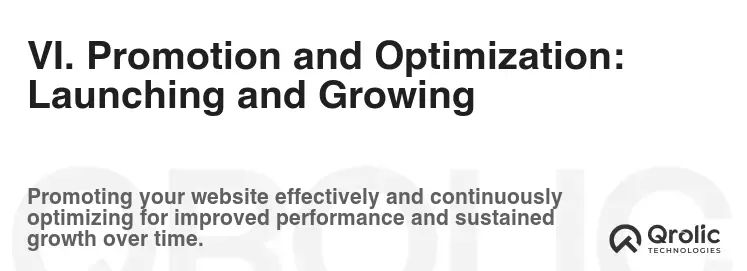
A. SEO Best Practices: Ranking Higher
Ongoing SEO is crucial for attracting organic traffic to your website.
-
Why is this crucial? Ranking higher in search engine results will increase your website’s visibility and drive more leads.
Key SEO practices:
- Keyword research: Continuously research and update your keyword strategy.
- On-page optimization: Optimize your website’s content, titles, and meta descriptions for relevant keywords.
- Off-page optimization: Build high-quality backlinks from other websites.
- Content marketing: Create valuable and engaging content that attracts and retains visitors.
- Technical SEO: Ensure your website is technically sound and easy for search engines to crawl and index.
- Monitor your results: Track your website’s performance and make adjustments as needed.
B. Social Media Integration: Amplifying Your Reach
Integrating your website with social media platforms can help you amplify your reach and drive traffic to your website.
-
Why is this crucial? Social media is a powerful tool for building brand awareness, engaging with your audience, and generating leads.
Strategies for social media integration:
- Add social sharing buttons: Make it easy for visitors to share your content on social media.
- Embed social media feeds: Display your social media feeds on your website.
- Promote your website on social media: Share your website’s content on social media and encourage others to visit.
- Run social media contests and giveaways: Generate excitement and engagement.
- Engage with your audience: Respond to comments and questions on social media.
C. Email Marketing: Nurturing Leads
Email marketing is a powerful tool for nurturing leads and driving conversions.
-
Why is this crucial? Email allows you to communicate directly with your audience and provide them with valuable information and offers.
Strategies for email marketing:
- Build an email list: Offer a valuable incentive, such as a free ebook or consultation, in exchange for email addresses.
- Segment your list: Divide your email list into segments based on interests and demographics.
- Create engaging email content: Provide valuable information, advice, and offers.
- Personalize your emails: Use personalization to make your emails more relevant to each recipient.
- Track your results: Monitor your email open rates, click-through rates, and conversions.
D. Analytics and Tracking: Measuring Success
Tracking your website’s performance is essential for understanding what’s working and what’s not.
-
Why is this crucial? Analytics data provides valuable insights into your website’s traffic, user behavior, and conversions.
Tools for tracking website performance:
- Google Analytics: Provides detailed data on your website’s traffic, user behavior, and conversions.
- Google Search Console: Provides insights into your website’s search engine performance.
- Heatmaps: Visualizes user behavior on your website.
- A/B testing: Allows you to test different versions of your website to see which performs better.
VII. Qrolic Technologies: Your Partner in Digital Web Design

Qrolic Technologies is a leading provider of digital web design solutions, specializing in crafting high-performance websites for marketing agencies. We understand the unique needs of marketing agencies and can help you create a website that not only looks great but also drives leads and grows your business.
Why Choose Qrolic Technologies for Your Marketing Agency Website?
- Expertise in Marketing Agency Web Design: We have a deep understanding of the marketing industry and know what it takes to create a website that resonates with your target audience.
- Custom Design Solutions: We don’t believe in cookie-cutter websites. We’ll work with you to create a custom design that reflects your brand’s personality and values.
- SEO-Focused Approach: We build websites with SEO in mind from the ground up, ensuring that your website is optimized for search engines.
- Mobile-First Design: We create fully responsive websites that look great on all devices.
- Ongoing Support and Maintenance: We provide ongoing support and maintenance to ensure that your website is always up-to-date and secure.
- Performance Optimization: We optimize your website for speed and performance, ensuring a smooth user experience.
Qrolic Technologies Services:
- Website Design and Development: We create custom websites tailored to your specific needs.
- SEO Services: We help you rank higher in search engine results.
- Content Marketing: We create valuable and engaging content that attracts and retains visitors.
- Social Media Marketing: We help you build brand awareness and engage with your audience on social media.
- PPC Advertising: We manage your paid advertising campaigns to drive targeted traffic to your website.
Let Qrolic Technologies help you create a marketing agency website that sets you apart from the competition. Contact us today for a free consultation.
VIII. Conclusion: Building a Digital Asset

Creating a successful marketing agency website is an ongoing process. It requires careful planning, strategic design, compelling content, and continuous optimization. By following the steps outlined in this guide, you can build a digital asset that attracts leads, showcases your expertise, and grows your business. Remember to adapt and evolve your website as your agency grows and the digital landscape changes. Keep experimenting, keep analyzing, and keep improving to ensure your website remains a valuable tool for years to come.

